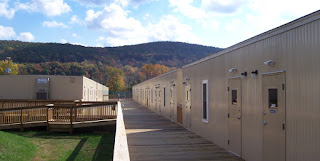Modular buildings are self-contained structures that are built
in a climate-controlled factory. Buildings are constructed in sections, or
modules, so they can be easily transported. The sections of the building are
shipped to the final job site where they are installed on a foundation created
specifically for the prefabricated construction. All of the necessary wiring is
done in the factory so utilities just need to be connected when the building
arrives at its location.
Modular buildings are made from concrete, steel or wood. Like site-built structures, the material used for prefabricated construction complies with local building codes. Custom buildings can be created to meet the needs of each modular building customer. The modular construction process is more environmentally-friendly than traditional construction because there is less product waste in the construction process. Modular buildings also tend to be more storm and earthquake resistant than site-built construction because buildings are designed to withstand the shipping process.
Because the modules are constructed inside a factory, weather is not a factor in the construction process. Modular construction projects are more likely to be completed on-time and on-budget than projects that are built on-site.
Most of the interior finishing is completed in the factory including carpeting, wiring and painting. Prefab construction arrives on-site nearly ready to be occupied. The structure is installed quickly, with limited disturbance to the community. Because the foundation is ready when the modules arrive at the site, the only things that need to be done are final exterior finishing, connections and landscaping.
Modular buildings range from basic structures used as additions to an existing building, to stand-alone, multi-story modular buildings customized to meet the specific needs of a client. Modular structures can be built quickly without sacrificing quality because of the streamlined construction process.
Modular buildings are made from concrete, steel or wood. Like site-built structures, the material used for prefabricated construction complies with local building codes. Custom buildings can be created to meet the needs of each modular building customer. The modular construction process is more environmentally-friendly than traditional construction because there is less product waste in the construction process. Modular buildings also tend to be more storm and earthquake resistant than site-built construction because buildings are designed to withstand the shipping process.
Because the modules are constructed inside a factory, weather is not a factor in the construction process. Modular construction projects are more likely to be completed on-time and on-budget than projects that are built on-site.
Most of the interior finishing is completed in the factory including carpeting, wiring and painting. Prefab construction arrives on-site nearly ready to be occupied. The structure is installed quickly, with limited disturbance to the community. Because the foundation is ready when the modules arrive at the site, the only things that need to be done are final exterior finishing, connections and landscaping.
Modular buildings range from basic structures used as additions to an existing building, to stand-alone, multi-story modular buildings customized to meet the specific needs of a client. Modular structures can be built quickly without sacrificing quality because of the streamlined construction process.


No comments:
Post a Comment